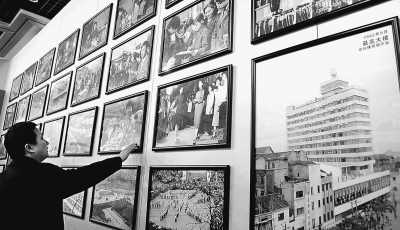American men Charlie Erickson, Jay Thornhill and Tyler McNew creating an e-commerce website called Baopals, which navigates Alibaba’s Taobao and Tmall in English translation, are seen on the rooftop of a building against the skyline of the Shanghai Tower, the Shanghai World Financial Center, the Oriental Pearl TV Tower and other high-rise buildings and skyscrapers in Shanghai, China, 9 August 2017.
About 800,000 foreigners living in China have experienced both the hardships and benefits of the country’s development. A look at China through their eyes provides insights into how the nation has been transformed and what it can offer the world.
An American in Xiamen
In 1988, William Brown, an MBA professor at Xiamen University, moved to Xiamen, a coastal garden city in east China’s Fujian Province, with his wife and two sons.
“I chose Xiamen University because it was the only university that allowed foreigners to take their families with them to learn Chinese at that time,” he said.
The Brown family flew from California to Hong Kong, where they took a grueling 18-hour boat ride to reach the coastal city.
Brown said he has witnessed China change from being “really backward” to moderately prosperous over 30 years.
In addition to teaching, he has developed English websites and published more than 10 English books about Xiamen.
Brown said he was excited when he once walked into a bookstore and saw several young students reading his books with a dictionary in their hands.
“The young people love their city and want to know a foreigner’s perspective on it,” he said.
This inspired him to publish the Chinese edition of the book “Discover Gulangyu.” This small island in Xiamen entered the UNESCO world heritage list in July this year for its cultural history and historic buildings.
“Only when the youth understand history can they walk into the future,” he said.
He was excited when the city of Xiamen hosted the BRICS summit from September 3 to 5.
“The G7 and G20 are the past, while BRICS is the future,” he said.
He said it is right that China has put forward the concept of “BRICS Plus” by inviting Egypt, Mexico, Thailand, Tajikistan and Guinea for dialogue.
A Korean in Hefei
When Korean teacher Cho Sung Hye landed in Hefei, capital of east China’s Anhui Province, in 1996, she had no idea she would be staying for so long. In 2006, she became the first person from South Korea to get China’s “green card” for permanent residence.
“None of my friends back home knew where Hefei was in China, and there was not a single foreigner that I could find in the city,” Cho said in fluent Chinese.
She remembered that 1996 was just four years after the late Chinese leader Deng Xiaoping made a series of landmark speeches marking China’s opening up and modernization.
There were only eight students in her Korean language class, which was held in the smallest classroom in Hefei College. Now the school has four Korean major classes, enrolling 500 students a year.
Over the past 20 years, Cho has seen 3,500 of her students go to South Korea for further studies.
She said it is the students’ thirst for learning that inspires her.
“Even at that time, I could feel China’s shining vigor and that it was on the way to rejuvenation into a great international power,” she said.
In 2016 the 57-year-old woman started a cultural exchange business that recruits international talent to Anhui.
“China’s wheel of development won’t stop rolling. Too many foreign people that I know are eager to study, work and live here,” she said.
A Japanese in Beijing
Toshio Fukuda, a Japanese nano-tech scientist, made his first visit to Beijing in 1995, attending a manufacturing technology summit at the invitation of China’s Ministry of Science and Technology.
Since then, his ties with China have continued, teaching as a visiting professor in a number of China’s high-tech institutions. In 2000, he decided to base all of his research work at Beijing Institute of Technology (BIT) and has been there ever since.
“As a scientist, I want the micro-nano field to grow bigger and deeper, no matter where my research is based,” he said.
He said that Chinese people are very hard-working. When he first came to China, the only computer integrated manufacturing was in a lab at Tsinghua University.
“The Chinese government did not have a lot of funding, but it funded Tsinghua’s research,” he said.
By 2000, he could see that research into robotic technology was spreading to science institutes all over China.
Fukuda said he chose BIT as his base because of the research environment, and because the National Science Foundation provided funding for his work.
China is his home now, and many people tell him that he is already half-Chinese. His favorite food is hot-pot, a spicy Sichuan-style food, and his youngest daughter also speaks Chinese.


留言
您必须登陆 才能发表评论。